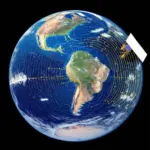Have you ever stood on the rim of the Grand Canyon and heard a distant echo? Or listened to the roar of a jumbo jet flying high above, wondering how far its sound could travel? The reach of sound is a fascinating concept, linking us to the world around us. But just how far can a sound wave travel? Let’s delve into the science of acoustics and discover the answer!
Factors Influencing Sound Wave Travel Distance
Unlike light, which can travel through the vacuum of space, sound relies on a medium to propagate. This medium can be a gas (like air), a liquid (like water), or even a solid (like the earth itself).
Several factors influence how far a sound wave can travel:
- Medium: Sound travels fastest through solids, followed by liquids, and slowest through gases. Imagine the difference between placing your ear on a railroad track versus listening for a train in the open air – the vibrations through the solid steel travel much farther and faster.
- Temperature: As temperature increases, sound waves travel faster. This is why sound seems to carry further on a hot summer day compared to a chilly winter evening.
- Humidity: Higher humidity levels allow sound to travel further, which is why sounds might feel “muffled” on a dry day.
- Frequency: Lower frequency sounds (think deep bass notes) generally travel further than higher frequency sounds (like a high-pitched whistle). This is because lower frequencies lose energy at a slower rate as they travel through a medium.
- Obstacles: Buildings, trees, and even wind can absorb and scatter sound waves, limiting their travel distance.
Putting it into Perspective: Real-World Examples
The actual distance a sound wave can travel varies greatly. A whisper might only reach a few feet, while the eruption of Krakatoa in 1883 was heard thousands of miles away!
- Urban Soundscapes: In a bustling city like New York, the constant din of traffic, construction, and human activity creates a complex soundscape. While individual sounds may be lost in the noise, the overall effect can be heard for miles.
- Ocean Depths: Sound travels surprisingly well underwater. Whales utilize low-frequency calls that can travel hundreds of miles through the ocean depths, a phenomenon crucial for communication within these massive creatures.
- Quietest Place on Earth: On the other end of the spectrum, the “quietest room in the world” at Orfield Laboratories in Minnesota is designed to absorb almost all sound. Spending time in this anechoic chamber can be a disorienting experience, highlighting just how accustomed we are to the presence of sound.
Planning Your Travels? Consider the Soundscape
When planning your next trip, consider the soundscape you’d like to experience. Will it be the tranquil quiet of a secluded mountaintop retreat or the vibrant energy of a bustling market square?
“Our surroundings shape our experiences, and sound plays a powerful role in that,” notes travel expert Dr. Emily Carter in her book, “The Sensory Traveler.” “By consciously choosing destinations with soundscapes that resonate with us, we can enhance our travel experiences.”
 Traveler Listening to Nature
Traveler Listening to Nature
FAQs about Sound Wave Travel
How does sound travel faster in water than air?
Sound travels faster in water because water molecules are packed more closely together than air molecules. This denser medium allows sound waves to transfer energy more efficiently.
What is the loudest sound ever recorded?
The loudest sound ever recorded was the eruption of the Krakatoa volcano in 1883. The sound was so powerful that it ruptured the eardrums of people 40 miles away and was heard over 3,000 miles from its origin.
Can sound travel through a vacuum?
No, sound cannot travel through a vacuum. Sound waves require a medium, such as air, water, or a solid, to propagate.
Embracing the World of Sound
From the crashing waves on a beach to the laughter of loved ones, sound is an integral part of the human experience. Understanding how sound travels enhances our appreciation for the world around us. So, the next time you hear a distant sound, take a moment to consider the journey it took to reach your ears!
For more fascinating insights into the science of sound and its impact on our world, visit travelcar.edu.vn. Discover how sound shapes our travels and explore the diverse soundscapes awaiting your next adventure.
 Ocean Waves Crashing on Shore
Ocean Waves Crashing on Shore

